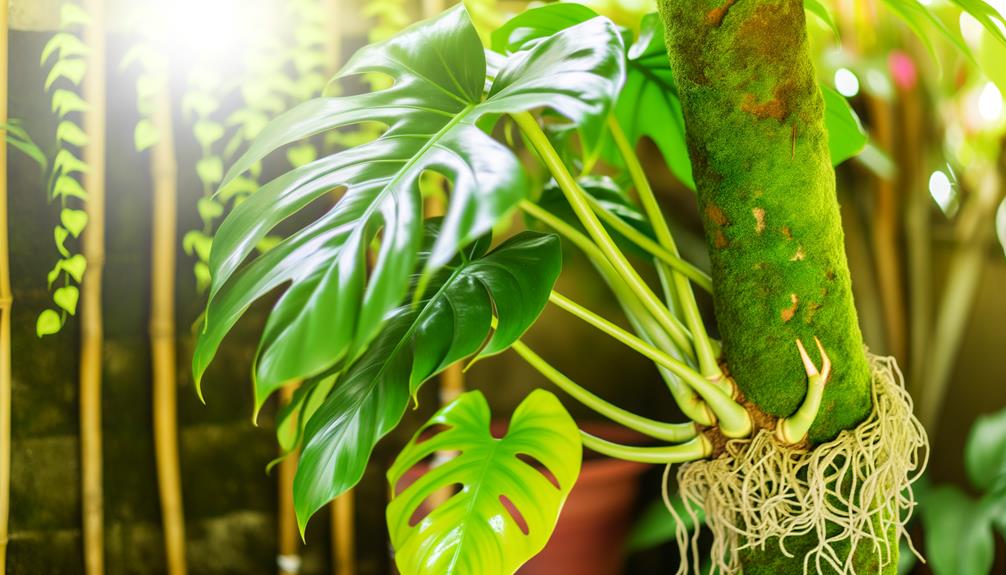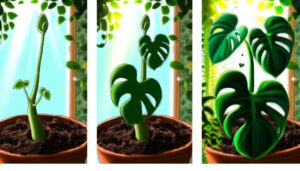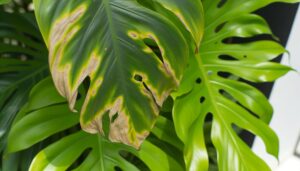Benefits of Using a Moss Pole for Monstera Deliciosa!
A moss pole for Monstera Deliciosa notably aids in vertical growth, mimicking its natural climbing habitat. It supports aerial roots, promoting robust stem elongation and morphological development.
Empirical studies affirm that moss poles enhance leaf fenestration, leading to larger, more fenestrated leaves. This support system also increases stability, reducing the risk of the plant toppling, and optimizes water retention through the hygroscopic properties of sphagnum moss.
Additionally, better air circulation is facilitated, lowering the risk of fungal infections and improving photosynthetic efficiency. For further insights into these multifaceted advantages, consider exploring the intricate benefits.

Key Takeaways
- Enhances vertical growth by providing structural support, mimicking the Monstera’s natural climbing environment.
- Promotes larger, more fenestrated leaves, improving overall leaf morphology.
- Increases plant stability, reducing the risk of toppling and mechanical stress.
- Improves air circulation, reducing fungal infection risk and enhancing photosynthesis.
- Optimizes water retention, ensuring consistent hydration and robust root development.
Enhanced Vertical Growth

Utilizing a moss pole for Monstera Deliciosa enhances vertical growth by providing structural support that mimics the plant’s natural climbing environment. Monstera Deliciosa, an epiphytic species, demonstrates a preference for vertical orientation, utilizing aerial roots to anchor onto trees in its native habitats.
Introducing a moss pole replicates this arboreal context, facilitating the plant’s innate vining behavior. Empirical evidence indicates that vertical support structures promote more robust stem elongation and improved morphological development.
The moss pole’s fibrous surface offers a suitable substrate for aerial root attachment, enhancing nutrient and moisture absorption, thereby bolstering overall growth.
This structural support mitigates mechanical stress on the plant, reducing the risk of stem breakage and promoting sustained vertical development.
Improved Leaf Fenestration
Utilizing a moss pole for Monstera Deliciosa facilitates improved leaf fenestration by enhancing leaf growth and providing natural climbing support.
The vertical structure encourages the plant to mimic its natural epiphytic environment, which promotes the development of larger, more fenestrated leaves.
Empirical studies have demonstrated that Monstera plants exhibiting greater vertical extension and stability through moss poles exhibit more pronounced fenestration patterns.
Enhanced Leaf Growth
Enhanced leaf growth in Monstera Deliciosa, characterized by improved leaf fenestration, is primarily a result of the plant’s increased access to vertical support and ideal light exposure provided by a moss pole.
Utilizing a moss pole maximizes the plant’s photosynthetic efficiency, which in turn promotes the development of fenestrated leaves leaves with characteristic splits and holes. This phenomenon can be attributed to the enhanced activation of growth hormones such as auxins, which are stimulated by vertical growth.
| Aspect | Moss Pole Support | No Moss Pole Support |
|---|---|---|
| Leaf Size | Larger | Smaller |
| Fenestration | More Pronounced | Less Pronounced |
| Light Exposure | Optimum | Suboptimal |
| Growth Rate | Accelerated | Slower |
| Hormonal Activity (Auxins) | Elevated | Standard |
This data illustrates the correlation between moss pole usage and the enhanced morphological characteristics of Monstera Deliciosa leaves.
Natural Climbing Support
Through the provision of natural climbing support, Monstera Deliciosa exhibits greatly enhanced leaf fenestration due to the mechanical stimulation and increased exposure to light. When a Monstera attaches its aerial roots to a moss pole, it mimics its natural epiphytic behavior, which is essential for optimal physiological development.
The mechanical stimulation from the pole encourages stronger stem growth and more pronounced fenestration in the leaves. Additionally, the vertical growth orientation facilitated by the moss pole ensures that the plant receives more uniform light exposure.
Studies have shown that such conditions can greatly improve the photosynthetic efficiency of Monstera Deliciosa, leading to healthier and more aesthetically pleasing foliage.
Therefore, moss poles serve as a necessary tool for maximizing plant vitality and ornamental appeal.
Increased Stability

A moss pole provides increased stability to Monstera Deliciosa by offering a robust structural support system that mimics the plant’s natural climbing habitat. Monstera Deliciosa, an epiphytic species, naturally climbs trees to reach light, leveraging aerial roots for anchorage.
The moss pole serves a similar function, allowing these roots to penetrate and secure themselves, thereby enhancing vertical growth. This structural support mitigates the risk of the plant toppling under its weight, which can be substantial due to its large, fenestrated leaves.
Empirical evidence suggests that plants with adequate support systems exhibit improved growth rates and reduced mechanical stress. Using a moss pole not only stabilizes the plant but also contributes to its overall health and vigor.
Better Air Circulation
Incorporating a moss pole into the cultivation of Monstera Deliciosa facilitates better air circulation around the plant’s foliage, which is essential for reducing the risk of fungal infections and promoting ideal photosynthesis.
By encouraging the plant to grow vertically, a moss pole allows air to flow freely between the leaves, mitigating conditions conducive to pathogen proliferation. Enhanced air circulation also aids in the evaporation of excess moisture, further reducing fungal threats.
Additionally, ideal airflow is important for efficient gas exchange, a fundamental process in photosynthesis. Empirical studies indicate that such structural support systems can greatly improve plant health and vitality.
| Factor | Impact |
|---|---|
| Airflow Increase | Reduces fungal infection risk |
| Moisture Evaporation | Prevents waterlogging |
| Gas Exchange | Enhances photosynthetic efficiency |
This table concisely presents the significant impacts of improved air circulation.
Optimized Water Retention

The use of a moss pole for Monstera Deliciosa not only enhances air circulation but also optimizes water retention, creating a microenvironment that supports sustained hydration for the plant’s aerial roots.
Moss poles, made of sphagnum moss, possess hygroscopic properties, meaning they can absorb and retain substantial amounts of water. This stored moisture is then gradually released, ensuring consistent hydration levels at the root zone.
Empirical studies have shown that consistent hydration promotes robust root development and enhances nutrient uptake efficiency. Additionally, the moss’s capillary action assists in the upward movement of water, mimicking the plant’s natural habitat where aerial roots cling to moist tree trunks.
This optimized water retention is essential for maintaining the Monstera’s overall health and vigorous growth.
Aesthetic Appeal
Integrating a moss pole into the care regimen of Monstera Deliciosa greatly enhances its aesthetic appeal by providing a naturalistic, vertical structure that complements the plant’s sprawling growth habit.
This vertical support mimics the Monstera’s natural habitat, where it climbs trees, thereby encouraging the development of larger, fenestrated leaves. Scientifically, the moss pole facilitates positive phototropism, guiding the plant towards best light exposure, which enhances its visual vibrancy.
Additionally, the moisture-retentive properties of the moss contribute to lush, healthy foliage, thereby amplifying the plant’s ornamental value. Evidence indicates that the vertical growth enabled by a moss pole reduces leaf crowding, promoting a more sculptural and visually appealing form, ideal for interior botanical displays.
Conclusion
To sum up, the utilization of a moss pole for Monstera deliciosa offers numerous advantages, including:
- Enhanced vertical growth
- Improved leaf fenestration
- Increased stability
- Better air circulation
- Optimized water retention
- Aesthetic appeal
Some may argue that a moss pole is an unnecessary accessory; however, empirical evidence supports its role in mimicking the plant’s natural habitat, thereby promoting healthier and more vigorous growth.
Such benefits underscore the moss pole’s efficacy as an indispensable tool for Monstera cultivation.






